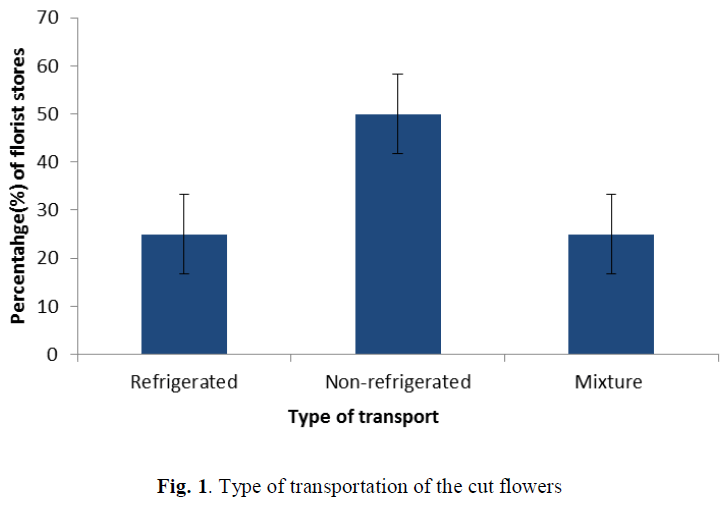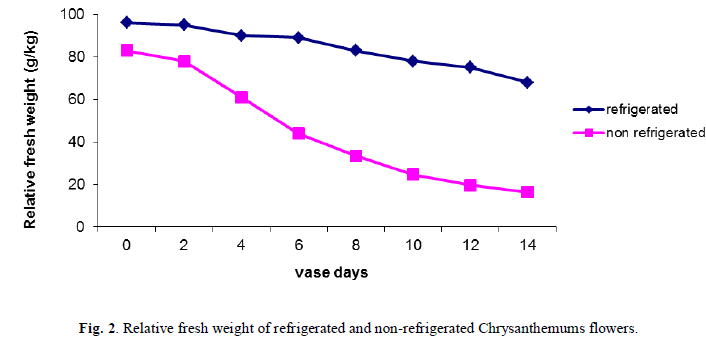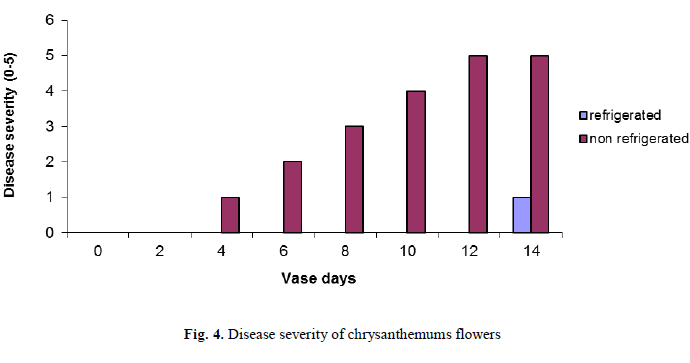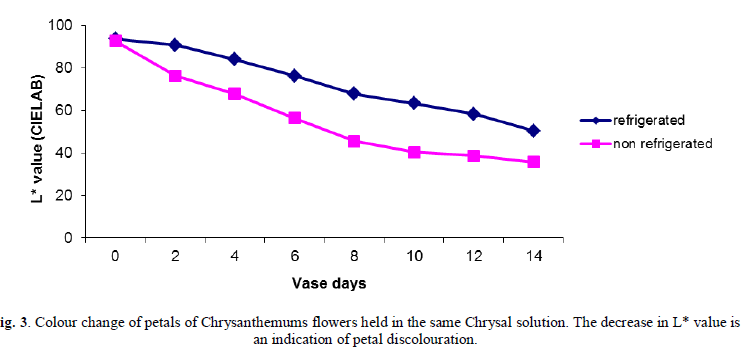ISSN ONLINE(2319-8753)PRINT(2347-6710)
ISSN ONLINE(2319-8753)PRINT(2347-6710)
Tshwenyane, S.O1., Legwaila, I.A2 and Madome, K3, T Mathowa4
|
| Related article at Pubmed, Scholar Google |
Visit for more related articles at International Journal of Innovative Research in Science, Engineering and Technology
Florist industry is a relatively new industry in Botswana with a shift from using artificial flowers to fresh flowers in arrangements. However, Botswana has a very small production of cut flowers which mainly focuses on summer flowers such as Limonium perezii (Blue sea lavender), Strelitzia reginae (Bird of paradise). This then means that over 90% of the cut flowers used by florists are imported from neighbouring countries such South Africa. The flowers are imported mainly by road due to the expensive air freight costs. Therefore, the type of transportation plays a crucial role in the postharvest quality of the flowers. Flowers that were refrigerated during transportation showed a delay in petal discoloration with an L* value of 76.27 for refrigerated flowers compared to 56.36 of non-refrigerated flowers on day 6. There was a significant increase in fresh weight loss in non-refrigerated flowers than refrigerated flowers. Weight loss after 2 days in retail display was higher in non-refrigerated flowers and continued to decline compared to refrigerated flowers. Transporting chrysanthemums in refrigerated trucks improved vase life up to 14 days compared to 8 days of nonrefrigerated transport. It was concluded that maintaining low temperature during transportation extends the vase life. This study evaluated the effects of refrigerated compared to non-refrigerated transportation on the postharvest quality of cut chrysanthemums flowers (Dendranthema x grandiflorum) during retail display
Keywords |
| refrigeration, Botswana, Chrysanthemums. |
INTRODUCTION |
| The Botswana floriculture industry is dependent on flowers imported from South Africa. Some of these flowers are transported in either refrigerated or non-refrigerated transport. The importance of temperature controlled transportation of flowers cannot be over-emphasized since temperature affect respiration which in turn affects the vase life and other postharvest quality traits of cut flowers [1] Some florists use refrigerated trucks to transport and deliver their flowers, the trucks are set to a temperature of 0 to 5oC [2]. Cut flowers retain their freshness considerably longer if they are refrigerated before they are used in floral arrangements. Low temperatures after harvesting extend the vase life of the flower by reducing its level of respiration, limiting its loss of water, and restricting the flower’s ethylene production and its susceptibility to the effects of ethylene. At a temperature of 1°C, many flowers use one-tenth of the amount of sugars that they use at 20°C, while flowers stored at temperatures of 20°C are 1000 times more susceptible to ethylene damage than when they have a product temperature of 2°C [3]. Most of the postharvest research on temperature controlled transport has been conducted on cut roses, cut gerbera 2; 4; 5] and more importantly the work is done in developed countries with less or no information for developing countries where non- refrigerated trucks are mostly used. This study seeks to establish how temperature affects the quality of cut chrysanthemums flowers (Dendranthema x grandiflorum) after transportation in either refrigerated or non-refrigerated trucks. |
MATERIALS AND METHODS |
| Experimental Design |
| Chrysanthemums cut flowers (Dendranthema x grandiflorum) of stem lengths of 46 cm were purchased from local florist stores. The choice of these florist stores was based on how they manage temperature during transportation of their flowers from South Africa. The flowers were taken to Botswana College of Agriculture Crop Physiology laboratory. On arrival at the laboratory, the bottom 2 cm of the flowers was cut under water. The flowers were then placed in chrysal chrysanthemum flower food solution. Each vase contained 1.0L of chrysal solution with 5 flower stems. For the control, the vases were filled with tap water. Tap water was used because the florists and consumers use tap water to fill their vases after purchase. Vases were arranged in a completely randomized design (CRD). All flowers were held at room temperature (20 ± 4oC), relative humidity (RH) of 60% and light was provided by cool- white Sylvania fluorescent lamps at 1000 Lux. |
| Data Collection |
| Mode of transportation |
| A structured questionnaire was used to interview the florists on whether they used refrigerated or non-refrigerated transport for their flowers from South Africa. |
| Fresh weight changes |
| For determination of changes in fresh weight during flower development stages, stem fresh weight (FW) and vase weight (container + vase solution) were recorded every second day from day 0. The stem fresh weight and vase weight were used to calculate relative fresh weight (RFW) according to [6]. The relative fresh weight of cut the stems were calculated as follows: |
| RFW (%) = (FW t/ FW t=0) X 100 |
| Where: FW t is the fresh weight of the stem (g) at t days. |
| FW t=0 is the fresh weight of the same stem (g) at t=day-0 |
| Vase life determination |
| Flower longevity were recorded as days of vase life from the time chrysanthemums cut flowers were placed into vases (day 0) until flowers lost turgidity, flowers began to discolour and abscission began to occur on petals and leaves. The vase life of chrysanthemums cut flowers was terminated when 50% of the chrysanthemums showed signs of colour fading and/or signs of wilting. |
| `Incidence of disease |
| The disease severity on the petals was assessed using a scale of 0 to 5 [7] 0: no lesions on the petals |
| 1: 1 to 5 % rotting of the petals |
| 2: 5 to 25% rotting of the petals |
| 3: 25 to 50% rotting of the petals |
| 4: 50 to 90% rotting; complete rotting of the petals |
| 5: 100% rotting and petal abscission. |
| Colour measurement |
| The colour of petals was measured every second day using a Minolta CR-200 Chroma meter using the CIELAB (L*, a*, b*) colour space. Only L* was measured which indicated lightness which ranges from 0-100. |
| Data Analysis |
| Analysis of variance was performed on the data using the general linear models (Proc GLM) procedure of the statistical analysis system (SAS, 2012). The means were separated using the Least Significant Difference at P=0.05. |
RESULTS AND DISCUSSION |
| All florist stores indicated that they imported their cut flowers from South Africa. Some of the reasons advanced for the importation included that most flowers are not grown locally; the quality of those available locally is poor and that poor soils hindered flower production in Botswana. Some of the florist stores also indicated that they used non-refrigerated trucks to transport their flowers, others used refrigerated trucks while others used both. Fig. 1 shows that fifty percent (50%) of florist stores use non-refrigerated transport while twenty five percent (25%) use refrigerated transport. Twenty five percent (25%) use both refrigerated and non-refrigerated transport. |
 |
| Effect of transport on relative fresh weight |
| Refrigerated transportation caused the chrysanthemums cut flowers to maintain higher fresh weight for a longer period because flowers loose less water at low temperatures. One of the most important factors that affect flower longevity is their ability to maintain turgidity [8]. A high level of turgidity is necessary for maintaining freshness of cut flowers. |
 |
| Effect of transport on vase life |
| The vase life of refrigerated chrysanthemums flowers was 14 days and 8 days for non-refrigerated cut flowers. Low temperature in refrigerated transport slowed the respiration rate of the flowers and prolonged their vase life. This is consistent with the recommendation of Dole and Wilkins [1] that commercial storage of most cut flowers should be at 0oC to 1 ºC. Tapia [9] also concluded that rapid cooling and proper refrigeration are essential to maintain quality and satisfactory vase life of cut flowers and foliage. Refrigerated transportation prolonged the vase life of chrysanthemums cut flowers as evidenced by increase in Chrysal solution uptake. Chrysal solution contained a germicide, sucrose, acid and surfactants. Keeping flowers in vase solutions containing sucrose has also been shown to extend their vase life [10]. Supplying cut flowers with exogenous sugar maintain the pool of dry matter and respirable substrates, especially in petals, thus promoting respiration and extending longevity. |
| Effects of transport on development of disease |
| There was a highly significant difference (P<0.01) in the development of disease symptoms between the refrigerated and non-refrigerated chrysanthemums flowers. Refrigeration during transport delayed development of diseases on the flowers until day 14 (scale 1) while non-refrigerated chrysanthemums showed disease symptoms as early as day 4. Thereafter disease severity on non-refrigerated chrysanthemums increased rapidly and the scale reached maximum on day 12 (scale 5) (Fig. 4). The decrease in disease severity in refrigerated flowers was low because low temperature retards the activity of disease causing microorganisms [11]. The most commonly encountered disease organism, gray mold (Botrytis cinerea), can germinate wherever moisture is present. In the humid environment of the flower head, it can even grow, at near freezing albeit more slowly [9]. |
 |
| Effects of transport on petal discolouration |
| There was a significant difference (P<0.05) in the L* value of the refrigerated flowers compared to the non-refrigerated flowers. The decrease in L* value is an indication of discoloration of petal (Fig. 3). Transporting chrysanthemums in nonrefrigerated trucks later accelerated loss of colour. High temperatures are reported to cause a loss of pigmentation in petals [12]. Furthermore, colour fading has been reported in roses due to temperature and time of harvesting [13]. Grotewold [14] adds that colour fading is a common phenomenon in petal pigmentation. Refrigerated cut Flowers showed a slow rate of discolouration of petals, this was because low temperature inhibited ethylene biosynthesis and action. Ethylene has been shown to promote petal abscission and colour fading (senescence) [3]. |
 |
CONCLUSION |
| The results of this study suggest that vase life of chrysanthemums cut flowers can be improved by transporting the flowers using refrigerated trucks. |
References |
|